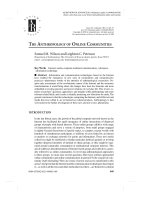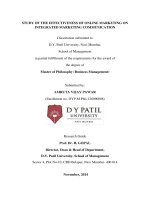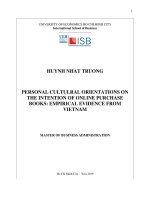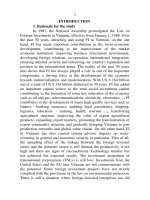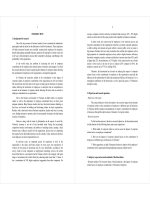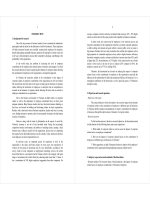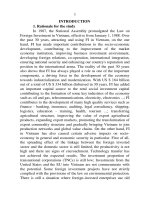Research the activities of online marketing by viral video in vietnam
Bạn đang xem bản rút gọn của tài liệu. Xem và tải ngay bản đầy đủ của tài liệu tại đây (1.1 MB, 91 trang )
VIETNAM NATIONAL UNIVERSITY, HANOI
INTERNATIONAL SCHOOL
GRADUATION PROJECT
PROJECT NAME: RESEARCH THE ACTIVITIES OF ONLINE MARKETING BY
VIRAL VIDEO IN VIET NAM
Student’s name: Tran Thi Phuong Thanh
Hanoi - Year 2020
VIETNAM NATIONAL UNIVERSITY, HANOI
INTERNATIONAL SCHOOL
GRADUATION PROJECT
PROJECT NAME: RESEARCH THE ACTIVITIES OF ONLINE MARKETING BY
VIRAL VIDEO IN VIET NAM
SUPERVISOR: Associate Prof. Pham Thi Lien
STUDENT: Tran Thi Phuong Thanh
STUDENT ID: 16071110
COHORT: IB2016C
MAJOR: International Business
Hanoi - Year 2020
2
LETTER OF DECLARATION
I hereby declare that the Graduation Project: “Research the activities of online marketing
by viral video in Viet Nam” is the results of my own research and has never been
published in any work of others. During the implementation process of this project, I
have seriously taken research ethics; all findings of this project are results of my own
research and surveys; all references in this project are clearly cited according to
regulations.
I take full responsibility for the fidelity of the number and data and other contents of my
graduation project.
Hanoi, (day) 26 (month) 05 (year) 2020
Student
(Signature and Full name)
3
ACKNOWLEDGEMENT
During the period of studying, I received lots of enthusiastic assistances, generous
supports and insightful comments to overcome all difficulties and complete the research
successfully.
Firstly, I would like to express special thanks to my supervisor Associate Prof. Pham Thi
Lien for giving me the opportunity to finish my graduation project at Hanoi National
University – International School. She always provides invaluable guidance and teaches
me the methodology to carry out this research as well as present it as clearly as possible.
Her advices and vision have deeply motivate me. I would like to greatly appreciate her
very much for what she has gave me.
Secondly, I sincerely thanks to Viet Nam National University – International School to
create a favourable environment to promote and help me to gain expert knowledge,
improve my skills as well. Their helps would inspired me to finish the study as good as
possible.
Finally, I would like to express my gratitude and appreciation to my friends in my
university for their constant encouragement. They always raise my spirits to keep moving
on conducting the research on time. Especially, I am deeply grateful to my parents for
their loves and sacrifices for educating and pushing me out my limit.
4
TABLE OF CONTENT
TABLE OF NOTATIONS AND ABBREVIATIONS .................................................... 7
LIST OF TABLE ............................................................................................................... 8
LIST OF CHARTS AND FIGURES ............................................................................... 9
ABSTRACT ..................................................................................................................... 10
CHAPTER 1: INTRODUCTION .................................................................................. 11
1.1 Background of the research .................................................................................. 11
1.2 Scope of the research ............................................................................................. 15
1.3 Research objectives and research questions........................................................ 15
1.4 Research method .................................................................................................... 16
1.5 The structure of research ...................................................................................... 16
CHAPTER 2: LITERATURE REVIEW ...................................................................... 18
2.1 Review the previous researches ............................................................................ 18
2.1.1 Viral marketing ................................................................................................. 18
2.1.2 Viral advertising ................................................................................................ 19
2.1.3 Sharing intention ............................................................................................... 20
2.1.4 Sharing acceptance ............................................................................................ 21
2.2 Conceptual framework and hypothesis ............................................................... 22
2.2.1 Conceptual framework ...................................................................................... 22
2.2.2 Hypothesis development ................................................................................... 25
2.2.2.1 Brand relationship strength influence on ad sharing intention ................. 25
2.2.2.2 Sharing motivation ..................................................................................... 27
2.2.2.3 Opinion seeking propensity ........................................................................ 28
2.2.2.4 Brand relationship strength influence on ad sharing acceptance.............. 29
2.2.2.5 Interpersonal relationship .......................................................................... 29
2.2.2.6 Opinion giving propensity .......................................................................... 30
CHAPTER 3: RESEARCH METHODOLOGY .......................................................... 32
3.1 Survey Design ......................................................................................................... 32
3.2 Data collection ........................................................................................................ 38
3.3 Research method .................................................................................................... 40
5
3.4 Measurement of research model .......................................................................... 43
CHAPTER 4: DATA ANALYSIS .................................................................................. 46
4.1 Demographic profile .............................................................................................. 46
4.2 Analysis and hypothesis testing ............................................................................ 48
4.2.1 Assessment of Convergent validity ................................................................... 48
4.2.2 Assessment of Discriminant validity ................................................................ 49
4.2.3 Assessment of Bootstrapping ............................................................................ 52
CHAPTER 5: CONCLUSION AND RECOMMENDATION .................................... 58
5.1 Conclusion .............................................................................................................. 58
5.1.1 Sharing intention process .................................................................................. 58
5.1.2 Sharing acceptance process ............................................................................... 58
5.2 Recommendation ................................................................................................... 59
5.3 Limitation ............................................................................................................... 60
REFERENCES ................................................................................................................ 62
APPENDIX....................................................................................................................... 67
6
TABLE OF NOTATIONS AND ABBREVIATIONS
In the research, I used these alphabets for abbreviation to easy follow. The below table
would be described in detail.
Abbreviation
Meaning
eWOM
Electronic word of mouth
SEM
Structural equation modeling
CB-SEM
Covariance-based SEM
NEUSREL
Nonlinear Universal Structural Relational
Modeling
PLS
Partial Least Squares
AVE
Average Variance Extracted
SRMR
Standardized root mean square residual
CR
Composite Reliability
HTMT
Heterotrait – Monotrait Ratio
7
LIST OF TABLES
Table 1: Items considered for the research mode ............................................................. 25
Table 2: List of sample videos .......................................................................................... 32
Table 3: Factors and variables in the research.................................................................. 38
Table 4: List of class participation in the survey .............................................................. 39
Table 5: List of videos in the survey ................................................................................ 40
Table 6: Demographic Profile .......................................................................................... 47
Table 7: Construct reliability and validity in sharing intention........................................ 48
Table 8: Construct reliability and validity in sharing acceptance .................................... 49
Table 9: Heterotrait – Monotrait Ratio (HTMT) in sharing intention .............................. 50
Table 10: Discriminant validity in sharing intention ........................................................ 51
Table 11: Heterotrait – Monotrait Ratio (HTMT) in sharing acceptance ........................ 51
Table 12: Discriminant validity in sharing acceptance .................................................... 52
Table 13: R Square in sharing intention ........................................................................... 53
Table 14: Total effects in sharing intention ...................................................................... 54
Table 15: R Square in sharing acceptance ........................................................................ 56
Table 16: Total effects in sharing acceptance .................................................................. 56
8
LIST OF CHARTS AND FIGURES
Figure 1:Sharing intention process .................................................................................... 23
Figure 2: Sharing acceptance process................................................................................ 23
Figure 3: The PLS-SEM test results in sharing intention .................................................. 55
Figure 4: The PLS-SEM test results in sharing acceptance .............................................. 57
9
ABSTRACT
Unlike the previous studies has researched activities of online marketing by viral video
with the basic elements created a viral advertising as content, run-time, title length, etc.
Therefore, this study attempts to evaluate the activities of online marketing by viral
video. From that finding the influence of factors to do viral ads in term of social process
at play when ads are shared as: Brand relationship strength, Sharing motivation, Opinion
seeking propensity, Interpersonal relationship strength and Opinion giving propensity
Into two processes: sharing intention process and sharing acceptance process. The paper
is applied structural equation modelling relied on partial least squares path modelling
(PLS-SEM) and using Smart-pls software to analysis. The valid data is 180 respondents,
who are belongs to the young generation in Vietnam. The survey is measured by a 5Likert scale and the model is tested with the index: reliability, convergent, discriminant
validity, R square, and bootstrapping. The result of the current research meets all the
conditions of the level of reliability, which assists the author concluding that all factors as
discussed above have considerable impact on sharing intention and sharing acceptance of
customers except from opinion giving propensity not accepted.
Keywords: Online marketing, Sharing intention, Sharing acceptance, Brand relationship,
Sharing motivation, Opinion seeking propensity, Interpersonal relationship, Opinion
giving propensity.
10
CHAPTER 1: INTRODUCTION
This chapter will introduce for the reader overall information of the topic: Research the
activities of online marketing by viral video in Viet Nam. In term of viral video, the
author would deeply concern consumers’ behavior and attitude through two concepts: ads
sharing intention and ads sharing acceptance. This part will provide background, the
reason why the author chooses the topic as well as introducing the research objectives
and research questions.
1.1 Background of the research
The Internet has become an indispensable part of people’s day. New digital technologies
have changed the ways of communication, collaboration and interaction. According to
Internet statistics by CBC channel (Anon, 2011), the number of Internet users is
increasing rapidly in every second. In 2011, the number has reached one billion and
continued rise up to two billion users in 2010. After five years, there are more three
billion people using the Internet in over the world. According to a recent report article of
The New York Times approximately 42% of the world’s population has access to the
Internet as of February 2016 (Anon., 2016). With the ongoing development of the new
technologies in today's world, traditional advertising has transformed to viral marketing’s
alternative strategies. Traditional advertising must keep updated its model because it is no
longer sufficient to build brand awareness and lead to purchase decision.
Besides, we are living in an age when changes in communications, business models,
information technologies are reshaping almost every aspect of modern-day life. The
world of digital media is changing at a phenomenal pace. Its constantly evolving
technologies, and the way people are using them, are transforming not just how we access
our information, but how we interact and communicate with others leading to changing
the way we choose and buy products and services.
11
Following Phillip Kotler’s analysed that research marketing and teaching is not an
exaggeration, spending time in digital marketing has achieved an enormous increase over
the method of traditional marketing (Kotler, 2011). Importantly, digital marketing also
show many different ways of marketing that is truly effective and save a huge cost for
businesses. According to IAB 2018 Video Ad Spend Study in 2018, marketer had spent
more than $15 million to advertise in brand digital and mobile video, the number hold
57% in 2018 (Anon., 2018). In this year, there are huge growth in online advertising as
TV advertising consumption approximately $35 billion (source: US Online and
Traditional Media 2018).
The approach of digital marketing is suitable with the behavior of consumer, they often
spend lots of time and effort to search products by mass media and social networks as
Facebook, Twitter, Instagram, etc. By 2019, the consumption of internet media per
person had surpassed 15% compared to the data in 2018 (Global use of social media sites
and devices-Global Webindex) (Index, 2019). On the other hand, businesses has faced
with a difficult challenge to manage effectively their budget. Unlike traditional
marketing, viral marketing based on social media to draw consumers to the marketing
content replacement publisher content with an ad message. The definition of reach in
digital marketing is acquired by an organic process that consumers would see and
approach viral ads which is shared by other people through social networks. The content
of viral marketing is considered successful when it can reach an amount of audience and
increase greatly views. Because of its benefits, many scholars in over the world has
studied how we can take advantage of its advantages and limit its disadvantages. Most of
them has tried to answer the question “What makes a video go viral?”
The scholars as Berger and Milkman (2012); Goodrich, Schiller and Galletta (2015);
Hsieh, Hsieh and Tang (2012); Nelson-Field (2013) had explored the factors related to
emotions as happy, sad, funny, surprised, etc., would be able to attract lost of audience,
from that increase the likelihood of sharing intention and acceptance shared information
12
((2012), 2012), (Goodrich, 2015), (Hsieh, 2012), (Nelson-Field, 2013). The finding
creates a good recipe for making video going viral that many big brands such as Unilever,
Coca Cola, Apple, etc. In the other side, Eckler and Bolls (2011); Nikolinakou and King
(2018); Southgate, Westoby and Page (2010); Tsai and Hsiang- Ming (2014) investigated
in the tone of viral video, they found positive tone which contribute for videos going viral
(Bolls, 2011), (King, 2018), (Southgate, 2010), (Ming, 2014). An typical illustration for
the hypothesis is Pampers brand which is professional in producing toddler products; In
2017 Pamper had run a campaign with the viral videos “Love the Change” which evoked
pleasant emotions from consumers when its message is the love of family inspired for
their baby. Furthermore, among of the elements created a viral video, Hayes, Shan and
King (2018) always emphasized the relationship between brand and consumer, it plays a
vital role for developing the direction of businesses (Hayes, 2018). When consumers have
positive attitude towards to brands, they are willing and commit themselves to using the
brands’ products. The relationship directly affect on consumer behavior (repurchase,
commitment, retention and positive word of mouth with other people). The same way of
making a video going viral, the link of brand and consumer is main factor for re-sharing
while relationships effect on referral acceptance.
In deeply research, Shehu, Bijmolt, and Clement (2016) indicate some detail components
for going viral video such as beginning, peak, and end that influent to sharing intention.
According to Freytag’s Pyramid, following five-act (exposition, rising action, climax,
falling action and denouement) such as Super Bowl TV Ads, whose ads are successful
since it develops based on the standard five-point, not have any story less than a five-act
story (Shehu, 2016). The research focus on the connection between story genre and viral
ad video, which is the key to motivate sharing and attract viewer attention. For example,
a viral video has three-act story (climax, falling action and exposition), which is better
and gain much more views and shares than a viral video with only one-act story. Another
research of Tyler West (2011) was designed to investigate the elements as title length,
run-time (West, 2011). The finding of the research proves that marketer should optimize
13
the file name of viral video, rename with specific keyword that describe the idea of the
video in few words and ensure using the right keywords. Moreover, by understanding the
way of optimizing length for viral video plays a considerable role in making a viral video.
Most of the viral video in the world take place in a short time which does not mean your
video has to limit the time constraints of the video, but your video had better to cut the
excess on your branded video. It significantly increase the likelihood of viewers watching
entire the viral video. He also explains that the length of video depends on your purpose,
if you want to provide a deep information video, you would make a long-time video or
suggest viewers the further link in the description.
A recent article in Hubspot with entitled “6 Viral Video Marketing Examples That Will
Never Get Old” is great example of the sometimes unlikely popularity of certain
YouTube videos. “Dollar shave club: our blades are F***ing great”, the video below is
over five years old, and yet, out of all of Dollar Shave Club’s YouTube videos -- of
which there are more than 50 -- it remains the world’s leading brand, with over 24
million views (Old, n.d.). Personally, I think this has to be the most clever viral video
ever produced. It’s informative, highlights the businesses USPs, and best of all, is
absolutely hilarious. The other one is TrueMoveH: "Giving", a mobile communication
provider in Thailand, triggered leaky eyeballs everywhere when it published this video in
2013. To date, it has over 20 million views and continues to be the brand’s most popular
YouTube video. When it comes to brands using YouTube, there are plenty of great
videos out there. Unfortunately, there still have plenty of bad ones even though they
invested a significant resource such as Trivializing Suicide: Hyundai, just this past year,
Hyundai released a commercial on YouTube that make the egregious mistake of making
light of a very sensitive issue – suicide. Their “Pipe Job” video showed a man attempting
suicide via exhaust fume inhalation in his garage. However, in the video, the man is
unable to go through with it because he is in a Hyundai ix35 – a fuel cell vehicle with a
tail pipe that discharges water vapor. After facing criticism, the company ultimately
apologized. Why do some videos become wildly popular while others do not?
14
Appreciation the significance of factors making a viral video or a viral advertising, the
author decides to analysis what factors influence to a viral video. The activities of online
marketing by viral video in Viet Nam. A video will become popular through a viral
process of Internet sharing, typically through social networks as Facebook, YouTube, Tik
Tok, etc. To better understanding the author will study into two processes: Ads sharing
intention and ads sharing acceptance. Hence, the paper attempts to help marketers or
businesses having the overall view about a viral video to possibly do marketing
effectively and efficiently. Especially, the author recognizes that there are a few
researches in Viet Nam study in this field; therefore she hopes that from the exploration
of research, they may improve their strategy and their resources to focus which factors to
maximize their profit.
1.2 Scope of the research
This study will focus on exploring the activities of online marketing through viral video
and to answer how factors in viral video effect on ads sharing intention and acceptance
shared ads. The data collection will be carried out 100% at Viet Nam National University
on 11st May, 2020 - 12th and the process of analyzing is completed on May 20th, 2020.
The respondents who present for young generation in Vietnam create trend and easily
absorb it, especially in marketing. This research will not include other problems that are
not related to the objectives of the research. The author conducts the research and gives
the results through the utilization of questionnaire to the students as a survey and
reference based on the standard criteria.
1.3 Research objectives and research questions
With the provided information and theories over several decades, the author hopes to
expand the existing knowledge: The activities of online marketing by viral video in Viet
Nam. Therefore, the research objectives will follow as below:
15
1. To help the reader to understand factors influence in a viral video or viral
advertising
2. To recognize the role of two processes: ads sharing intention and ads sharing
acceptance with a viral video or viral ad.
In order to achieve these objects, two questions are addressed as follow:
RQ1: Which of factors will positively affect on ad sharing intention?
RQ2: Which of factors will positively affect on ad sharing acceptance?
1.4 Research method
The paper was employed Smart-pls to evaluate the activities of online marketing using
viral advertising through the two processes: Sharing intention and sharing acceptance
which enables the researchers to codify qualitative data such as texts into quantitative
data in order to obtain a more systematic data for further analysis. The author analysis
through 3 steps as below:
• Step 1: Read the previous research which relate to the elements discussed in the
part of conceptual framework
• Step 2: Establish the model to collect data and design questionnaire based on the
findings of the previous research.
• Step 3: Using Smart-pls software to analysis the results from survey. Structural
equation modeling (SEM) is the method assistance researchers to examine the
relationship between variables
• Step 4: Indicate which factors have greater impact on two processes and draw
conclusion for the paper.
1.5 The structure of research
16
Based on the research objectives and research questions, the structure of research is
divided into five chapters:
Chapter I: Introduction
The part will provide information to make clear the purpose and the reason why the
author carries the research for readers.
Chapter II: Literature review
In this part, the author investigated the previous research to gain the basic knowledge
about the subject of research.
Chapter III: Methodology
This part will present the method of the research and explain how the method is applied
in this paper.
Chapter IV: Data analysis
As the result of research, the author will analysis indicators and variables, then examine
the hypothesis
Chapter V: Conclusion and Limitation
This chapter will answer the research objectives and research questions. Besides, the
author reveals the limitation of research.
17
CHAPTER 2: LITERATURE REVIEW
This literature review examines and evaluates a number of studies, existing literature, and
campaigns that get at the elements of viral advertisements. In this case it is viral video
that most likely to motivate sharing. The literature contains content about the reasons
why people share content, the method by which the content of the advertisement,
reactions of the consumer that motivate sharing, and reasons why an advertisement may
spread virally.
2.1 Review the previous research
2.1.1 Viral marketing
The growth of social media has created a new marketing environment where the
traditional marketing rules are no longer used. Welker considers viral marketing as
“strategies that allow an easier, accelerated, and cost-reduced transmission of messages
by creating environments for a self-replicating, exponentially increasing diffusion,
spiritualization, and impact of the message” (Welker, 2002). Marketers have new
approaches to the customer mainly depending on online and social media. Viral
marketing has become increasingly relevant over the last decade with the uprising of
social media networks such as Facebook, Twitter, and YouTube. Small and large
companies alike have used viral marketing techniques to promote a wide variety of
products. Online viral marketing is still very much in its infancy.
Previously, many scholars have explained the concept of viral marketing as Wilson
described viral marketing as any strategy that encourages individuals to pass on a
marketing message to others, thus creating the potential for exponential growth in the
exposure and influence of the message (Wilson, 2001). Like viruses, it takes advantage of
rapid multiplication to blow-up the message to thousands, to millions within only seconds
through Internet. Another side, off the Internet, viral marketing has been referred to as
"word-of-mouth," "creating a buzz," the only difference is not using digital media, unlike
18
television marketing, radio marketing, billboards, or fliers, requires on direct consumer
input. There are many people who have mistakenly opinion about viral marketing, it is
that viral marketing activities take place through e-mail, nearly always selling an on-line
mechanism. Scholar Nucifora also make clear that it can be transferred to other digital
media of the Web such as graphics, software downloads, screen savers, short video clips
and messages distributed by mobile phones (Nucifora, 2000).
Traditional marketing allows consumers to passively absorb messages, whereas viral
marketing make customer willing to take an active part in spreading a message
(Stonedahl, 2010). Sexton explained the definition of “viral” is that videos, images and
phrases become popular on the Internet, they are to go “viral” (Sexton, 2011). The word
“viral” in viral marketing refers to popularity and exponential spread of ideas and
messages of marketer. When a marketing campaign becomes popular online at a very
rapid pace, then it is considered viral marketing.
2.1.2 Viral advertising
Maria Petrescu and Pradeep Korgaonkar has shown the influence of viral ads on business
ịn their research, viral ads are an unconventional marketing technique which makes
favour for small business and low budget campaigns with unique and compelling
messages and content (Korgaonkar, 2011). Viral ads had better to fit in the content and
idea of the marketer’s strategy to bring the best experiences for consumers. The research
has also pointed out that the ads are “commercial-free” which means they are focused on
entertaining and engaging the customer, rather than presenting a call to action.
Generating product or brand awareness, not on transmitting traditional advertising
messages or a list of information about the product are focused by viral advertising.
Several studies classify the key concept of viral advertising as unpaid electronic including
e-mail, web, or social media. From consumer to consumer, advertising is generated and
distributed based on ad content likeability, entertainment, and controversial
19
characteristics. It is main factor of viral advertising and separates it from other form of
advertising. Following the research of Curz and Fill, Fattah and Welker regard to the idea
of controlling viral ads at least in a small scale (Fill, 2008), (Fattah, 2000), (Welker,
2002). As Keller defined, customer set the rules of engagement and marketers can lose
some control over what consumer post online (Keller, 2009).
From the agency perspective, they explain term of viral ads that are designed to be
discovered, watched, talked about, and shared in a digital social environment. With
emotional ads effectively made available by companies to target audiences online
(websites, social media, blogs, or video sites like YouTube and Vimeo) are more likely to
go viral. Typically companies as Samsung, Amazon, and Adidas employ viral video
advertising as a means to gain additional exposure, as well as to establish their brands as
trendsetters in a global marketplace. Samsung’s viral video ad Galaxy Note 7 achieved
30.3 million views in 2016 is good example in this case, which was partly organic reach
generated from social media (Advertising Age 2016) (Anon., 2016).
2.1.3 Sharing intention
To do an ad going viral, there have people to decide sharing the ad with their social
networks. By actively sharing an ad from official web (brand’s website), the initial
behavior is considered the most important dimension for doing a viral advertising.
Research in factors affection sharing intention has had many scholars measured which
factor is the most important as well as examine the relationship among factors. As Ali
Jolaee and Khalil Md Nor, Naser Khani, Rosman Md Yusoff show seven elements
impact on intention to share such as: self-efficacy, social networks, perceived extrinsic
rewards, attitude, organizational support, subjective norm, trust. According to the result
of the research indicate that three factors as social network, attitude and organizational
support which have respectively influence to sharing intention. In contrast, the group of
20
extrinsic rewards, subjective norm and trust only hold not considerable influence (Ali
Jolaee and Khalil Md Nor, 2013).
Eckler and Bolls, Nelson-Field also found out that social media users have sharing
behavior when they are positively engaged with the content of the ad. For example,
posting a video ad in social media may not necessarily be accompanied by a direct
statement of opinion in the form of a positive comment from the sharer. When consumers
have a positive attitude towards the viral ad, then they find its subject of the ad congruent
with their self-image (Bolls, 2011), (Nelson-Field, 2013).
2.1.4 Sharing acceptance
To do advertising going more viral, the ads must be accepted. The process of sharing
acceptance happens when referrer shares ads with someone by clicking on the ad. The
relationship of sharing intention and sharing acceptance strongly intertwine each other.
According to Chu&Kim; Ho and Dempsey; Phelps et al. , an ad would go to viral when
someone make the first decision to share the ad to an online social network (Chu, 2011),
(Dempsey, 2010), (Phelps, 2004). For example, when viewer watch a advertising video
that has interesting content, therefore, the person intend share it on his private account on
Facebook; From that other people possibly see the video. By the action of introducing an
ad from an off-site location (ex: click “share” from the brand’s website or share from
brand-sponsored newsfeed ad).
From the perspective of the previous researches, very little research has been conducted
in the behavior of sharing acceptance, the factor play a significant role in process making
ads going viral. The “viral” ads are considered successful when sharer share to sharer, by
exploiting the networks among consumers, marketer may take advantage of its to create a
viral ad. The sharing information must be accept, the process of sharing acceptance
includes the decision to choose absorb one’s information. Following Jameson L. Hayes,
& Karen Whitehill King & Artemio Ramirez Jr has indicated that the recipient–brand
21
relationship and the referrer–recipient relationship intertwine to influence sharing
acceptance (Hayes, 2018). Most viral advertising researches to date has focused on how
create a viral ad, passing on the process what make consumer having sharing intention
and acceptance sharing information. Therefore, based on the knowledge of factors
affecting to ads going viral, the author will further investigate in two separate sharing
process, namely sharing intention and sharing acceptance.
2.2 Conceptual framework and hypothesis
2.2.1 Conceptual framework
Based on the model, Jameson L.Hayes & Karen Whitehill King & Artemio Ramirez Jr
identified “a social exchange perspective on the ad referral processes” (Hayes, 2018). The
research model comprises of five constructs and all the elements has adjusted to ensure
that all factors are valid, hence the constructs represent as below. In this study, the author
will continue to research in detail the mediation of the model showing obviously throught
two process: sharing intention and acceptance sharing.
If an ad is to go viral, someone must make the initial decision to refer the ad to an online
social network. On Facebook, sharing intention is the act of introducing an ad to the
onlinenetwork from an off-site location (e.g., clicking “share” from the brand's website)
or by sharing a brand-sponsored newsfeed ad. Most viral advertising literature to date has
focused onpassing along viral ads to the exclusion of the initial referral decision.
To complete the exchange, the referral must be accepted. Ads sharing acceptance is the
decision to choose to expose one's self to a referred ad by clicking on the ad. It is
proposed that the recipient–brand relationship and the referrer–recipient relationship
intertwine. The recipient likely considers his/her relationship with the brand. Brand
satisfaction and trust (or lack thereof) derived from prior exchanges will inform the cost–
benefit analysis Stronger CBRs should enhance perceived outcomes encouraging
acceptance as uncertainty is reduced and greater intrinsic and expressive value is ascribed
22
to the brand. Hence, the model should be separate to make clearly two stages from the
beginning someone intention to share and to the stage of acceptance ads sharing to
complete view of the customer brand relationship influence on consumers’ behaviors.
Figure 1:Sharing intention process
Figure 2: Sharing acceptance process
23
Factors
Brand
Variables
Reference
Brand satisfaction
Hess and Story (2005)
Brand trust
Apostolos N. Giovanisa, Pinelopi
relationship
strength
Athanasopoulou (2014)
Batra (2012)
Opinion
Opinion giving propensity
propensity
Chu and Kim (2011)(Adapted from
Flynn, Goldsmith, and Eastman
1996)
Engel, Blackwell, and Miniard
(1990); Rogers (1983)
Shu-Chuan Chu, Yoojung Kim,
(2011)
Opinion seeking propensity
Chu and Kim (2011)(Adapted from
Flynn, Goldsmith, and Eastman
1996)
Katz and Lazarsfeld (1995)
Sharing
Internal
Kankanhalli, Tan, and Wei (2005)
motivation
Flynn, Goldsmith, and Eastman
(1996)
Sun (2006)
Angeliki Nikolinakoua and Karen
Whitehill King (2018)
Hirschman, & Holbrook (1982)
Patrick Mikalef , Michail Giannakos
and Adamantia Pateli (2013)
24
External
Patrick Mikalef , Michail Giannakos
and Adamantia Pateli (2012)
Angeliki
Table 1: Items considered for the research
modeNikolinakoua and Karen
Whitehill King (2018)
Interpersonal
Person to person
Argyle, 1999; De Leon, 2000;
relationship
Gutman, Sameroff, & Eccles, 2002;
strength
Martin, 2013
Leon, De (2000)
Person to organizes
Katz, Elihu/Lazarsfeld, Paul F.
(1955)
Dr. Randy Borum (2010)
Sharing
Ali Jolaee and Khalil Md Nor, Naser
intention
Khani, Rosman Md Yusoff (2013)
Bolls, Petya Eckler and Paul (2011)
Nelson-Field (2013)
Sharing
Chu&Kim (2011)
acceptance
Dempsey and Ho (2010)
Phelps, JOSEPH E. (2004)
Hayes, Shan and King (2018)
2.2.2 Hypothesis development
From the conceptual framework above, the author will analysis the following
hypothesis as below:
2.2.2.1 Brand relationship strength influence on ad sharing intention
Apostolos N. Giovanisa, Pinelopi Athanasopoulou had refered to brand relationship in
their research that consumers differentiate brands based on the relationships between
25
